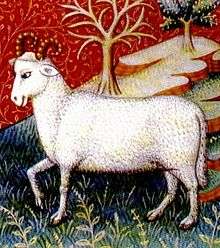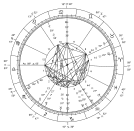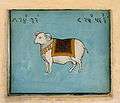Aries (astrology)
Aries (♈︎) /ˈɛəriːz/ (Latin for "ram") is the first astrological sign in the zodiac, spanning the first 30 degrees of celestial longitude (0°≤ λ <30°), and originates from the constellation of the same name. Under the tropical zodiac, the Sun transits this sign from approximately March 20 to April 21 each year.[2] This time duration is exactly the first month of the Solar Hijri calendar (Arabic Hamal/Persian Farvardin/Wray). [3]
| Aries | |
|---|---|
 | |
| Zodiac symbol | Ram |
| Duration (tropical, western) | March 20 – April 19 (2020, UT1)[1] |
| Constellation | Aries |
| Zodiac element | Fire |
| Zodiac quality | Cardinal |
| Sign ruler | Mars |
| Detriment | Venus |
| Exaltation | Sun |
| Fall | Saturn |
| Astrology |
|---|
 New millennium astrological chart |
| Background |
|
| Traditions |
| Branches |
|
According to the tropical system of astrology, the Sun enters the sign of Aries when it reaches the March equinox, which occurs on average on March 21 (by design). Because the Earth takes approximately 365.24 days to go around the Sun, the precise time of the equinox is not the same each year, and generally will occur about six hours later from one year to the next until reset by a leap year. February 29 of a leap year causes that year's vernal equinox to fall about eighteen hours earlier—according to the calendar—compared with the previous year. From 1800 to 2050 inclusive the vernal equinox date has (or will) range(d) from March 19 at 22:34 UT1 in 2048 to March 21 at 19:15 UT1 in 1903.[1]
Under the sidereal zodiac, the sun currently transits Aries from April 15 to 14 May (approximately).
Background
Aries is the first fire sign in the zodiac, the other fire signs being Leo and Sagittarius. Individuals born between these dates, depending on which system of astrology they subscribe to, may be called Arians or Ariens.[4] Aries colors are red and white. [5] In astrology, Aries is the cardinal sign of the fire trigon. It is one of the six positive signs.
The equivalent in the Hindu solar calendar is Meṣa.[6]
Mythology
In Greek Mythology, the symbol of the ram is based on the Chrysomallus, the flying ram that rescued Phrixus and Helle, the children of the Boeotian king Athamas and provided the Golden Fleece.
Gallery
 Mosaic in Maltezana near Analipsi, Astypalaia, 5th century CE.
Mosaic in Maltezana near Analipsi, Astypalaia, 5th century CE. Aries zodiac sign, Jantar Mantar, Jaipur, India. 18th century CE.
Aries zodiac sign, Jantar Mantar, Jaipur, India. 18th century CE. Aries, or al-ħamal, depicted in the 14th/15th century Arabic astrology text Book of Wonders.
Aries, or al-ħamal, depicted in the 14th/15th century Arabic astrology text Book of Wonders.
Notes
- Astronomical Applications Department 2011.
- Oxford n.d., s.v. Aries and Taurus.
- Atsma 2015.
- Oxford n.d., s.v. Arians.
- Orion 2011, p. 1.
- Raman 2003, pp. 10–19.
Works cited
- Astronomical Applications Department (2011). Multiyear Computer Interactive Almanac. 2.2.2. Washington DC: US Naval Observatory.CS1 maint: ref=harv (link) For time of Sun's entry or exit from a sign, calculate Longitude of Sun, apparent geocentric ecliptic of date, interpolated to find time of crossing 0°, 30°..... For list of vernal equinox dates calculate phenomena: solstices/equinoxes, choosing UT1 and years 1800 through 2050.
- Atsma, Aaron J. (2015). "Chrysomallus". The Theoi Project: Greek mythology.CS1 maint: ref=harv (link)
- Orion, Rae (2011). Astrology for Dummies. Hoboken, NJ: John Wiley & Sons. ISBN 9780470098400.CS1 maint: ref=harv (link)
- "Aries and Taurus". Oxford Dictionaries. n.d. Retrieved December 23, 2018.
- Raman, Bangalore V. (2003). Studies in Jaimini Astrology. Motilal Banarsidass. ISBN 978-81-208-1397-7.CS1 maint: ref=harv (link)
External links
| Wikimedia Commons has media related to Aries (astrology). |